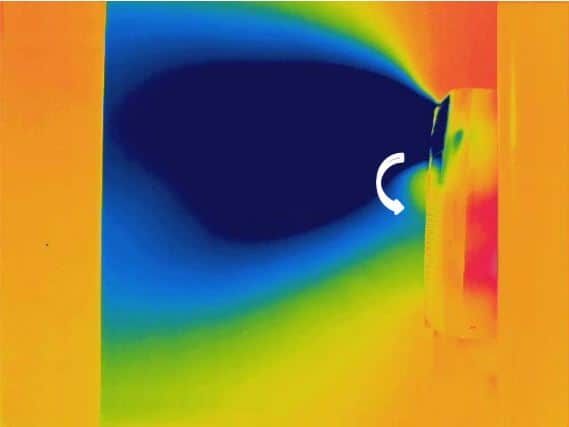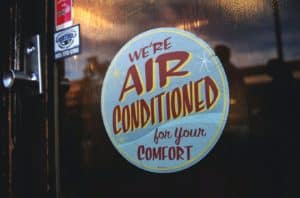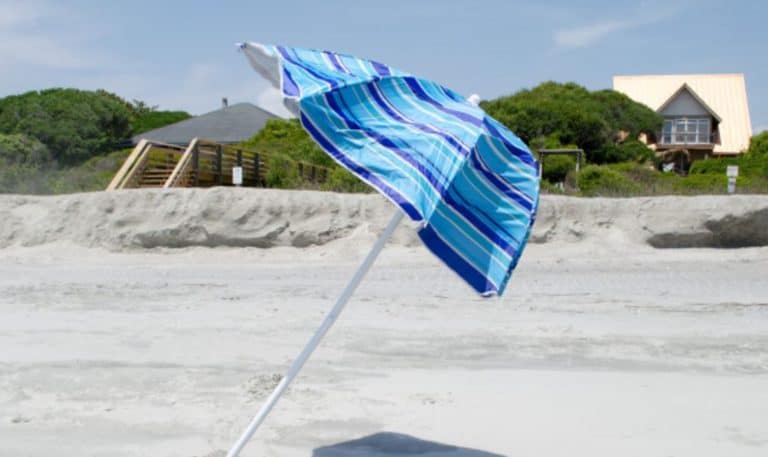When the heat really starts to build then usually you can chuckle and think “I’ve got A/C, I’ll be fine!” but I found these ideas for when that isn’t enough and what is more they can also save you money! Some of them require some further investment and planning but others just require your time and awareness of the impact a different approach can have on the temperature inside your house.
Did you know:
Your A/C is normally designed to cool to a MAXIMUM of ~20 degrees from the outside temperature.
i.e If its a 100 outside and your A/C is getting down to 80 then it is working well!
What Can I do TODAY when my Air Conditioning can’t keep up?
- Clean its air filters; ~ once a month! Replacing a clogged filter makes it more efficient and can reduce your energy consumption by up to 15% ! (Energy.gov/energysaver)
- Clean the external condenser unit; Remove any debris/dust build-up
- Cut back any shrubs or plants or move any objects (at least 2 feet) that may be reducing the airflow around the outside unit; the greater the airflow the more efficient the unit
- Without reducing the airflow try and ensure the outside unit is not in full direct sunshine; keeping the unit in shade will improve its efficiency but do not just stick a board straight on top as that will reduce the airflow
- Spray the condenser with water; this will aid cooling as the water evaporates which will improve the efficiency of the unit.
- (Central Air) Open ALL your Air Vents; closing some air vents will increase the pressure within the air ducts (more leaks) and cause back pressure on the cold air blower making it less efficient.
Did you know:
Air Conditioning also makes us feel cooler as it reduces the moisture in the air. When the humidity/moisture level is high, our ability to cool through perspiration is inhibited.
Air Conditioner Basics
An A/C uses the same sort of components as your refrigerator. There are, however, a few misconceptions and key things that will help you when thinking about how to make your house cooler.
Key Things:
- No air is moved from inside to outside; there are usually two fans/blowers that are used to blow the air across the evaporator (cool) inside the house and a different fan across the condenser (hot) outside. The only thing that gets moved from inside to out and back again is the refrigerant inside the sealed system tubes.
- The refrigerant changes from liquid to gas and back again as part of the cooling process. It is not ‘used up’ and unless you have a leak in the system should last for the lifetime of the unit.
- Most refrigerant leaks are initially due to poor installation or factory faults, damage, or after years of use the corrosion of the tubes due to formic acid eating away at the metal.
- Being outside the Condenser is more likely to get damaged and/or dirty. Extra care when mowing/weedwacking around the unit to avoid accidental breakage but also to avoid the coils getting dirty and the fan being blocked.
- Anything that reduces the heat flow or airflow will make the system have to work harder. Dirty air filters inside but also dirty coils outside are common problems. A special ‘comb’ can be purchased to help straighten damaged cooling fins that are restricting airflow.
How to Improve your Window A/C
Most of this information is sourced from the NREL laboratory tests undertaken for the Dept of Energy.
Seal Your Window Properly

In most cases the biggest loss of performance for Window A/C units is due to poor installation. This doesn’t stop the unit from working but causes a large amount of hot outside air leakage into the room. This significantly reduces the A/C’s efficiency, causing it to run more, working harder while also introducing more humidity into the room.
Illustration by Majorie Schott , NREL
Fortunately, for a few dollars ($20-25), you can easily rectify the problem with some foam panels, closed-cell foam strips, and some weatherproof tape. You can then properly seal the air gaps around the whole window as well as around the A/C unit. National Renewable Energy Laboratory testing has shown that even following most manufacturer’s instructions isn’t enough.
For the complete, step-by-step, photographic guide to the recommended installation method download their PDF.
Recirculation Issues
Most window or portable A/C units suffer from some level of recirculation, where the cold air being blown out of the top vent is drawn straight back into the unit!
This not only reduces the amount of cool air that goes into the room but also reduces the amount of warm air that is drawn into the unit to be cooled and dehumidified. A simple retrofit diverter between the cool air outlet and the warm air inlet will further enhance the performance of the unit.

Recirculation Issue with Window A/C Unit.
Cool, blue air, being blown out can be seen re-entering the air inlet.

Recirculation Divider Installed on Window A/C Unit
All the cool blue air is directed into the room and not drawn back into the unit.

This is an simple example of a suggested divider to fix the recirculation problem. As suggested by the NREL.
Tip:It should be noted that when not needed for cooling the whole unit should be removed or sealed up otherwise air will leak through the unit itself!
How to improve from your Central A/C
Open ALL your Air Vents
You might assume that by closing some of the Air Vents and cooling less rooms you are going to keep the other rooms cooler. This is not necessarily the case!
What happens is that the same blower then has to push the same amount of air through fewer holes. This causes the pressure inside the ducting to increase and also the amount of load that is put onto the blower.
The extra load on the blower can in some cases cause it to work slower but will make it work harder reducing its efficiency, lifespan and increasing its running costs.
The other problem with the increased pressure is it will also increase the amount of air that leaks out of the ducts!
Seal your Ducts
According to ENERGY STAR, in a typical home, about 20-30% of the air passing through the air duct system is lost, because of leaks, holes, and poorly connected ducts.
Repairing ducts that are often concealed in walls, ceiling, attics, and basements, can be difficult but there are things that you can do to improve duct performance in your house.
Start by sealing air leaks using mastic sealant or metal tape and insulating all the ducts that you can access such as those in attics, crawlspaces, unfinished basements, and garages. Also, make sure that the connections at vents and registers are well-sealed where they meet the floors, walls, and ceiling. These are common locations to find leaks and disconnected ductwork.
NOTE: Ironically, do NOT use Duct tape, as it is not considered long-lasting and will eventually need replacing!
Circulating Fans
Circulating fans include ceiling fans, table fans, floor fans, and fans mounted to poles or walls. These fans create a wind-chill effect that will make you more comfortable in your home, even if it’s also cooled by air conditioning.
Ceiling fans are usually the most effective as they circulate all the air in a room to create a draft. Table and floor fans can also be effective but the more direct airflow can be troublesome where objects or papers will be disturbed by the breeze. The use of a ceiling fans can allow you to raise the thermostat setting about ~4 degrees without impacting your comfort.
NOTE: Turn off fans when you leave a room; fans cool people, not rooms, by creating a wind-chill effect.
Avoiding Heat Build Up
Anything you can do to reduce how hot your house gets will obviously make the job of your A/C that much easier.
- Insulate your attic and walls, and seal cracks and openings to prevent warm air from leaking into your home
- Landscaping; shading from landscaping elements reduces solar heat absorbed by roofs and windows
- Install energy-efficient window coverings that let natural light in and prevent solar heat gain; during summer, keep the window coverings closed during the day to block the sun’s heat.
- Exterior Features; changing your outside space to keep your inside space cooler
- Use extraction fans/ventilation when taking a shower or bath and when cooking — this helps remove heat and humidity from your home.
- Don’t heat your home with appliances; avoid any activities that generate a lot of heat.
Insulation
It is often forgotten that insulation is as important in keeping cool in the summer as it is in keeping warm in the winter.
Heat flows from warmer to cooler until there is no longer a temperature difference.
This means that any heat gained in the summer must be removed by your cooling system. Properly insulating your home will decrease this ‘heat flow’ by providing an effective resistance to the flow of heat.
It is also worth considering a radiant barrier. Most common insulation materials work by slowing conductive heat flow; when the hot thing is actually in contact with the colder thing. Radiant barriers are for the heat flow that you feel when you are not touching the item, such as the heat inside the attic from the underside of the tiles. They work much like a mirror in reflecting the heat back.
Landscaping
Planting a deciduous tree with high, spreading leaves and branches to the south of your home can provide maximum summertime roof shading. Trees with crowns lower to the ground are more appropriate to the west, where shade is needed from lower afternoon sun angles.
Trees, shrubs, and groundcover plants can also shade the ground and pavement around the home. This reduces heat radiation and cools the air before it reaches your home’s walls and windows. For example you could plant a large bush or row of shrubs to shade a patio or driveway. Plant a hedge to shade a sidewalk. Build a trellis for climbing vines to shade a patio area.
Coming Soon – Check back for more comprehensive Landscaping Tips
Energy Efficient Windows Coverings
About 76% of sunlight that falls on standard double-pane windows enters to become heat.
By keeping windows coverings closed during the summer you can drastically reduce the heat gain.
This doesn’t mean you can’t have any natural light but rather in preference you should use those that don’t get direct sunlight. You can then alter which ones are opened and closed throughout the day to maximize the light and reduce the heat.
Horizontal Window blinds can be very popular for benefitting from natural daylight. They can be completely closed for full heat reflection but can also be angled to reflect some of the direct sunlight on to a light-colored ceiling which will diffuse the light without much heat or glare.
Exterior Features.
Exterior window coverings (shutters, awnings etc.) can also make a big difference. Energy.gov suggest that window awnings can reduce solar heat gain in the summer by up to 65% on south-facing windows and 77% on west-facing windows.
Many other features such as shade sails, patios, pergolas, solar screens can also be used to shade not only the window but also the side of your house.
Coming Soon – Check back for more comprehensive Window Covering Tips
Use extraction fans/ventilation
Bathing, washing laundry, and other activities can pump heat into your home. When you shower or take a bath, use the spot ventilation of a bathroom fan to extract the heat and humidity from your home. Ensure that any dryer is vented to the outside and the ducting is well sealed to avoid air ingress.
Where possible avoid using the oven; cook on the stovetop, or better yet, use only a microwave oven. When cooking use the spot ventilation of your oven hood extractor fan to help remove the heat from the house. Outdoor grilling is another great way to avoid cooking indoors.
Note: Turn off any exhaust fans within 20 mins of finishing cooking or bathing.
Don’t heat your home with appliances
Anything that is running will be generating some heat that needs to be removed. Avoid the obvious such as running a dishwasher, and using hot devices such as curling irons or hair dryers.
It’s also worth considering new appliances, most now have high energy efficiency ratings which means they will save you money but in many cases, much of the improvements come from reducing the amount of unnecessary heat that is produced. Buy an ENERGY STAR-qualified AC unit — on average, they’re up to 15 percent more efficient than standard models.
As an easy example new LED lightbulbs use dramatically less energy (cheaper) and also do not get anything like as hot. A double win!
Anything that you do not actually need to be on ALL the time should be unplugged ( DVD players, TVs, stereos, computers, power strips, and kitchen appliances) to avoid the so-called ‘vampire loads’ where appliances continue to draw a small amount of power even when they are switched off.
Do Misting Fans Really Work? What they don’t tell you!
Commercial misting fans are a popular addition for many events, agricultural and industrial spaces but how do they do in a patio type setting? Here I have covered all the different aspects from their water usage and usable range to climate suitability and how ‘wet’ you might get. Misting fans can be very effective; the…
Continue Reading Do Misting Fans Really Work? What they don’t tell you!
How Do Whole House Fans Work? A complete guide to Everything you need to know.
If you have or are considering, a whole house fan, then you have probably heard about the cost savings (~1/10th!) compared to A/C. I wanted to know if this was just the sales pitch but also to understand what else we needed to know! Having consulted manufacturers claims, HVAC websites, scientific studies as well as…
Continue Reading How Do Whole House Fans Work? A complete guide to Everything you need to know.
How to Stop Your Beach Umbrella from Blowing Away? A 3-minute Step-by-Step Guide with Tips.
Your Beach Umbrella blowing away can be a disaster for your day at the beach but even worse it can become a dangerous weapon with lots of sharp pointy bits. Data from the US Consumer Product Safety Commission (CPSC) indicates that more than 2,800 people were treated in hospitals for umbrella-related injuries between 2010 and…




